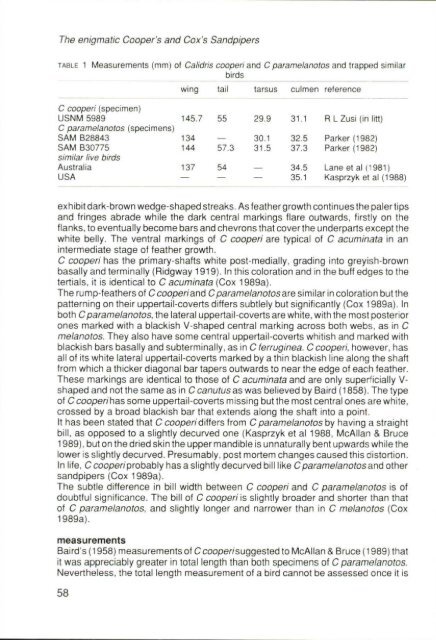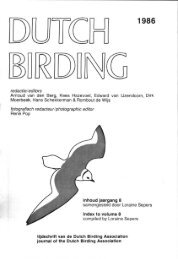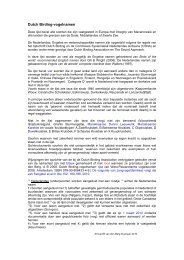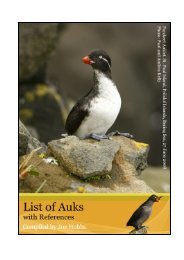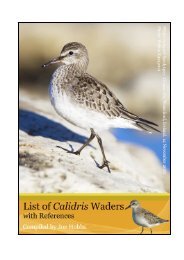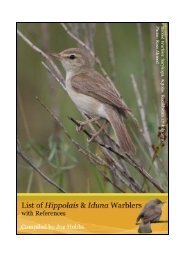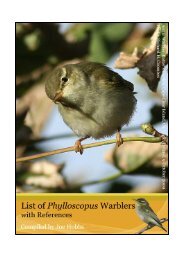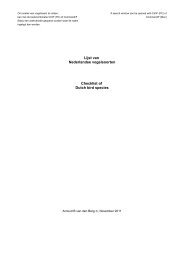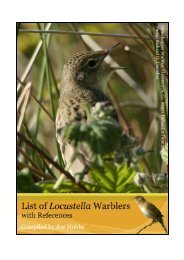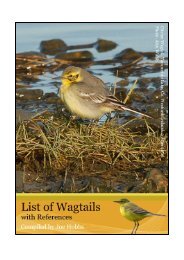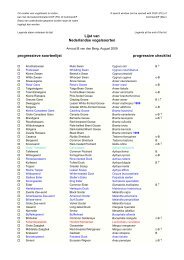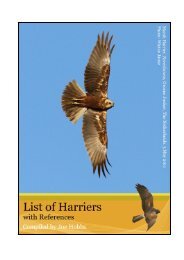You also want an ePaper? Increase the reach of your titles
YUMPU automatically turns print PDFs into web optimized ePapers that Google loves.
The enigmatic Cooper's and Cox's Sandpipers<br />
rABLE 1 Measurements (mm) of Calidris cooperi and C parameranotos and trapped simila r<br />
bird s<br />
wing tail tarsus culmen reference<br />
C cooperi (specimen )<br />
USNM 5989 145,7 55 29 .9 31 .1 R L Zusi (in litt )<br />
C paramelanotos (specimens )<br />
SAM B28843 134 - 30 .1 32 .5 Parker (1982 )<br />
SAM B30775 144 57 .3 31 .5 37 .3 Parker (1982 )<br />
similar líve birds<br />
Australia 137 54 - 34 .5 Lane et al i- 981 )<br />
USA - - - 35 .1 Kasprzyk et al (1988)<br />
exhibit dark-brown wedge-shaped streaks . As feather growth continues the paler tips<br />
and fringes abrade while the dark central markings flare outwards, flrstly on the<br />
flanks. to eventually become bars and chevrons that coverthe underparts except the<br />
white belly. The ventral markings of C cooperi are typical of C acumirtata in an<br />
intermediate stage of feather growth .<br />
C cooperi has the primary-shafts white post-medially, grading into greyish-brown<br />
basally and terminally (Ridgway 1919) . In this coloration and in the buff edges to the<br />
tertials . it is identical to C acuminata (Cox 1989a) .<br />
The rump-feathers of C cooperiand Cparamelanotosare similar in coloration but the<br />
patterning on their uppertaii-coverts differs subtlely but significantly (Cox 1989a) . In<br />
both C paramelanotos, the lateral uppertail-coverts are white, with the most posterior<br />
ones marked with a blackish V-shaped central marking across both webs ., as in C<br />
melanotos. They also have some central uppertail-coverts whitish and marked with<br />
blackish bars basally and subterminally, as in C ferrLgirrea. Ccooperr, however, has<br />
all of its white lateral uppertail-coverts marked by a thin blackish line along the shaft<br />
from which a thicker diagonal bar tapers outwards to near the edge of each teather .<br />
These markings are identical to those of C acurrrinata and are only super`icially Vshaped<br />
and not the same as in C canutus as was believed by Baird (1858) . The type<br />
of C coaperihas some uppertail-coverts missing but the most central ones are white .<br />
crossed by a broad blackish bar that extends along the shaft into a polnt .<br />
It has been stated that C cooperidiffers from C paramelanotos by having a straight<br />
bill, as opposed to a slightly decurved one (Kasprzyk et al 1988 . McAllan & Bruce<br />
1989) . but on the dried skin the upper mandible is unnaturaNy bent upwards while the<br />
lower is slightly decurved . Presumably. post mortem changes caused this eistortion .<br />
In life, C cooperiprobably has a slightly decurved bill like C paramelarrotos and other<br />
sandpipers (Cox 1989a) .<br />
The subtle difference in bill width between C cooperi and C paramelanotos is of<br />
doubtful significance . The bil{ of C cooperi is slightly broader and shorter than that<br />
of C parametanotos . and slightly longer and narrower than in C melanotos (Cox<br />
1989a ) .<br />
measurements<br />
Baird's (1958) measurerrlents of C cooperisuggested to McAllan & Bruce (1989) that<br />
it was appreciably greater in total length than both specimens of C paramelarrotos .<br />
Neverthe#ess, the total length measurement of a bird cannot be assessed once it i s<br />
58


